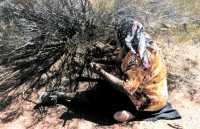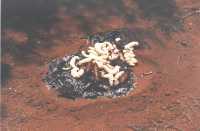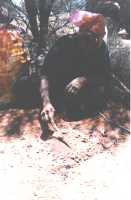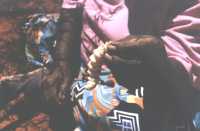This grub is the larvae of
a grey Cossid moth. They live in the roots of the Ilykuwara
(Witchetty Bush) (Acacia kempeana)
for several years before they emerge as a fully grown moth. They live off the nutrients in
the root, becoming fat and juicy, and causing the normally thin root to swell around them.

Eileen Crombie digging for Maku living in
the roots of the Ilykuwara
The swollen roots are close to the ground
surface and are broken off using a digging stick. The grubs are removed and either eaten
raw or kept for cooking later. Both larvae and pupae are eaten. To cook Maku, coals and
ash from a fire are laid out on the sand, the grubs are placed on top of it and more coals
are used to cover them. They are quickly cooked while stirring around in the coals. When
they are ready, the grubs are put into a hole in the sand and covered so they cool
quickly. Cooked in this manner, they taste like scrambled egg, and are very rich in
protein and fat.

Maku roasting in the hot ashes
Maku are also used to treat serious burns.
The grubs are crushed and pounded, then spread over the burn. Finally a bandage of bark is
used to protect the area for one to two days. This treatment leaves the burn victim with
minimal scarring.

|
